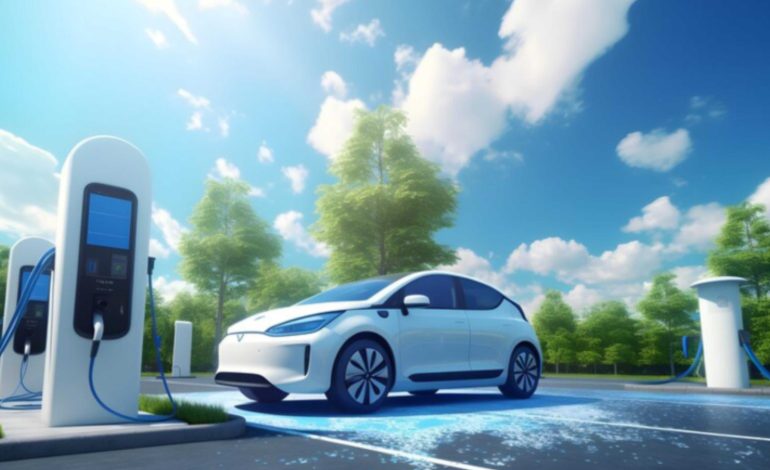
Electric Vehicles Revolution: Accelerating the Transition to Clean Transportation
Introduction
The transportation industry has undergone a dramatic change in the last several years due to the rise of electric cars (EVs) as a competitive alternative to conventional internal combustion engine vehicles. This technological revolution in transportation is not only a fad; rather, it is an essential step in the fight against climate change, the reduction of air pollution, and the achievement of sustainability objectives. The trend towards electrification is gaining speed as more and more businesses, governments, and consumers come to understand the advantages of electric vehicles. This blog delves into the electric vehicle revolution, examining its implications, obstacles, and future directions.
The Rise of Electric Vehicles
The idea of electric cars is not new; it was first proposed in the 1800s. But it hasn’t been until recently that EVs have become widely accepted due to a combination of customer choices, environmental concerns, and technology developments. With the release of models like the Nissan Leaf, Tesla Roadster, and Chevrolet Volt, electric car sales began to pick up steam in the early years of the twenty-first century. These innovators showed off the possibilities of electric propulsion, proving that EVs might be useful, effective, and consumer-friendly.
The popularity of electric vehicles has been largely fueled by developments in battery technology. EVs can now travel farther and charge more quickly thanks to lithium-ion batteries’ high energy density and enhanced durability. Furthermore, the price difference between electric and conventional automobiles has shrunk due to falling battery costs. Because of this, automakers everywhere have increased their efforts to electrify their fleets and have made significant investments in the R&D and manufacturing of EVs.
Impact of Electric Vehicles on the Environment
-
Zero Emissions:
Because they have no exhaust emissions, electric vehicles (EVs) are essential for lowering air pollution and enhancing the quality of the air in cities. Since EVs only run on electricity, they do not produce any direct emissions that cause smog, respiratory ailments, or environmental degradation. In contrast, conventional internal combustion engine vehicles release pollutants like carbon dioxide (CO2), nitrogen oxides (NOx), and particulate matter (PM).
-
Lifecycle Emissions:
Studies consistently demonstrate that throughout their entire lifecycle, including manufacturing, operation, and disposal, electric vehicles emit fewer greenhouse gases than their petrol or diesel counterparts. This is true even though the manufacturing process of EVs, particularly battery production, has an impact on the environment in terms of energy consumption and greenhouse gas emissions. The carbon footprint associated with charging EV batteries is further reduced when the electricity infrastructure transitions to greener, renewable energy sources including hydroelectric, solar, and wind power. This reduction is particularly noteworthy.
-
Resource Extraction:
The extraction of raw materials like lithium, cobalt, and nickel is necessary for the construction of EV batteries, which creates ethical and environmental questions. Particularly in areas where these minerals are abundant, extraction operations may result in habitat damage, water pollution, and negative effects on nearby communities. Furthermore, energy-intensive procedures are frequently used in the mining and processing of these resources, which increases carbon emissions and exacerbates environmental deterioration.
-
Battery Recycling:
Appropriate solutions for recycling and reuse are crucial in reducing the environmental impact of electric vehicle batteries. Battery recycling minimizes waste and lessens the need for new resource extraction by recovering precious materials like nickel, cobalt, and lithium. Furthermore, fresh batteries can be made from recycled components, encouraging a closed-loop, circular economy strategy that saves resources and lessens environmental impact.
-
Decarbonization Potential:
The environmental benefits of electric vehicles are anticipated to increase as the world’s energy landscape shifts towards decarbonization and makes greater investments in energy-efficient technologies and renewable energy infrastructure. Transportation systems can become less dependent on fossil fuels and more sustainable by incorporating electric vehicles (EVs) with renewable energy sources like wind turbines and solar photovoltaics. This will reduce greenhouse gas emissions and lessen the effects of climate change.
As a result, compared to conventional vehicles, electric vehicles provide several environmental benefits, such as emissions-free operation, reduced greenhouse gas emissions throughout their lifetime, and the ability to help with the shift to a more sustainable and clean transportation system. Thus, the electric vehicle revolution is surging day by day. However, addressing challenges related to resource extraction, battery recycling, and energy grid decarbonization is crucial to maximizing the environmental benefits of electric vehicles and achieving long-term sustainability goals.
Challenges and Opportunities of Using Electric Vehicles:
-
Charging Infrastructure:
- Challenge: Inadequate charging facilities can cause range anxiety and impede general adoption.
- Opportunity: Investing in fast-charging stations and other growing charging networks can allay worries and promote the adoption of EVs.
-
Battery Technology:
- Challenge: The energy density and lifespan of existing batteries are limited, which affects the pricing and performance of EVs.
- Opportunity: Research and development into cutting-edge battery chemistries, such as solid-state batteries, should continue to improve the durability and capacity of energy storage.
-
Upfront Cost:
- Challenge: Despite lower lifetime ownership costs, higher initial purchase prices of electric vehicles may discourage users.
- Opportunity: Tax credits and subsidies from the government can increase the financial accessibility of EVs and encourage their adoption.
-
Range Anxiety:
- Challenge: Consumer trust in electric vehicles (EVs) can be hindered by worries about the limited driving range and the accessibility of charging facilities.
- Opportunity: By expanding infrastructure and improving battery technology, we can reduce range anxiety and boost market adoption.
-
Supply Chain Sustainability:
- Challenge: Reliance on raw materials for battery manufacturing gives rise to moral and ethical questions, such as resource depletion and violations of human rights.
- Opportunity: You may lessen your impact on the environment and society by using sustainable procurement methods, supporting recycling programs, and looking into alternative materials.
-
Consumer Awareness:
- Challenge: Adoption of electric vehicles may be hampered by a lack of knowledge and instruction regarding their features and advantages.
- Opportunity: Consumer knowledge and confidence in EV technology can be raised by public awareness campaigns, educational initiatives, and test-drive programs.
-
Grid Integration:
- Challenge: There are load management, grid stability, and peak demand issues when integrating EV charging with the electrical grid.
- Opportunity: Time-of-use pricing, vehicle-to-grid (V2G) connectivity, and smart grid technology can balance electricity demand and optimize charging patterns.
-
Variety of Vehicles:
- Challenge: Consumer choice is limited by the scarcity of electric vehicle models, particularly in some vehicle classes or geographical areas.
- Opportunity: By selling more EVs in a wider range of vehicle segments, such as trucks, SUVs, and commercial vehicles, manufacturers may reach a wider audience and gain market share.
The Future of Electric Vehicles
The future of electric vehicles seems bright despite the obstacles, thanks to advances in technology, supportive policies, and changing customer perceptions. Automakers are responding to a variety of consumer tastes and market categories by introducing a growing array of electric models, spanning from compact cars to SUVs and trucks. Additionally gaining pace is the electrification of fleets, commercial vehicles, and public transit, which lowers emissions and lessens reliance on fossil fuels.
The ecosystem surrounding electric vehicles is about to undergo a revolution thanks to developments in autonomous driving, vehicle-to-grid integration, and smart charging technologies. These advancements will also increase sustainability, convenience, and efficiency. In addition to being essential parts of a broader ecosystem that also includes energy storage, renewable energy sources, and smart infrastructure, electric vehicles are more than just a means of transportation. We can develop a future transport system that is more sustainable, efficient, and robust by utilizing the synergies that exist between these sectors.
Conclusion
With its potential to contribute to lower carbon emissions, better air, and increased energy security, electric vehicles are ushering in a new era of mobility. In light of the pressing issues of climate change and environmental degradation, it is imperative that the transport industry be electrified now more than ever. We can hasten the transition to clean transportation and create a better, more sustainable future for future generations by making investments in policies that encourage the adoption of electric vehicles (EVs), developing battery technology, and building charging infrastructure. Electric cars are more than just transportation; they are forces for transformation that are fueling this electric vehicle revolution and bringing about a world that is healthier, greener, and wealthier.





